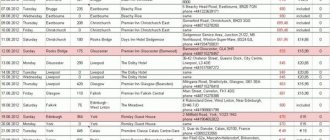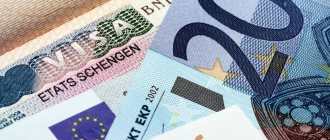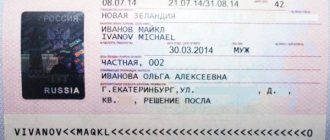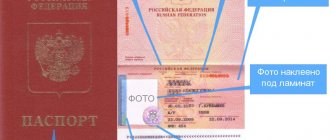Permission to enter another country is a special mark in the passport. You can see what a Schengen visa looks like by opening one of the pages of the international passport on which it is present. This is a kind of green “sticker” with the last and first name of the visa recipient, as well as the visa corridor deadlines. The country for which the visa was issued is also indicated on it. This does not mean that the person who receives it will be able to stay only in the specified state - Schengen opens access to another 26 EU countries that are part of the so-called Schengen zone.
What is a Schengen visa
A Schengen visa can be issued at the embassy of any European country. It gives you the opportunity to travel throughout Europe without issuing additional visas. The most popular type of Schengen is designated by the Latin letter “C” and is issued for a period of up to 90 days with different entry corridors (six months, a year, etc.). Multiple visas can be issued for up to 5 years. The “D” visa is also issued for longer periods – up to 180 days with the possibility of extension without leaving Russia. What is needed to obtain a Schengen visa?
- Collect a package of documents, which includes: application form, passport, certificate of employment, insurance, tour or hotel reservation, tickets.
- Pay the fee (30 euros at the visa center, 35 euros when submitting to the consulate).
- Submit the package of collected documentation and wait for a response (the average waiting period is 5-10 days).
According to the new rules of the EU Visa Code, even if you are denied entry into the country, you are required to provide a written explanation of why this happened. Previously, the consulate may not have commented on its decisions. If everything went well, then when you open your passport, you can find the coveted green sticker with your photo. For such stamps there are 8 sheets or 16 passport pages (o at the top). If the visa pages run out, the passport holder must issue a new document.
Decoding any Schengen visa is not particularly difficult. It must contain the permit number, country code, validity period, last day of stay in the Schengen zone, number of entries (1, 2 or Mult). The type must also be indicated (A – transit, C – for short-term stay (up to 90 days), D – for long-term stay).
What does a visa look like?
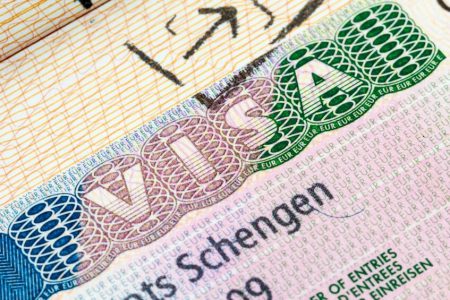
The Schengen visa is a relatively small colored sticker pasted onto the first of the free pages of the passport. To understand the definition of a Schengen visa, it is not necessary to know a foreign language at a fluent level. All codes and meanings given are easy to understand. In addition, the visa form is duplicated in French and the official language of the country to whose embassy you submitted documents.
What is needed to obtain a Schengen visa? In addition to the application form, the citizen is required to provide the embassy with a package of documents, including civil and foreign passports, a certificate of employment, medical insurance, justification for the purpose of the trip and two photographs 35 by 45 mm. Also, before submitting an application, you must pay a visa fee of 35 euros and a service fee - from 17 to 22 euros.
What information does it contain?
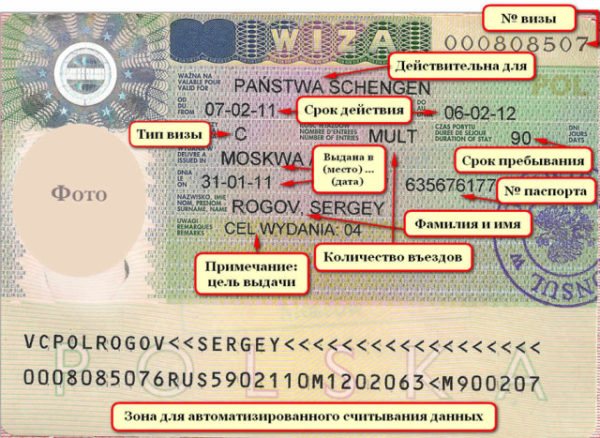
If it is difficult to understand how to read a Schengen visa correctly, you can start studying this issue from the very beginning: its number. In the upper right corner, directly above the date, eight numbers and one letter will be indicated - this code encrypts the name of the country that issued the permit.
If it is difficult to find where the Schengen visa number is, then you should pay attention to the yellow background right next to the name “Visa”. There is a high probability of confusion, since at the very bottom there is also a whole series of numbers that can be mistaken for a number. However, this is completely different information - machine-readable encoding, which is read by a special device at the border.
At the beginning of the encoding there is the letter V, then the symbol of the visa type (A, C, D), country code, personal data of the owner, visa number and other data. Using this code, even the nationality of the recipient of the entry permit and his gender can be considered a scanner. All this information is indispensable for personal identification at the border checkpoint.
general information
The Schengen visa is pasted into the passport and is a green sticker the size of a passport page. The visa contains not only information about the visa itself, but also other important data.
Immediately after receiving the visa, check whether the data specified in it matches the passport data. If you discover an error, please notify the visa officer who issued your visa immediately.
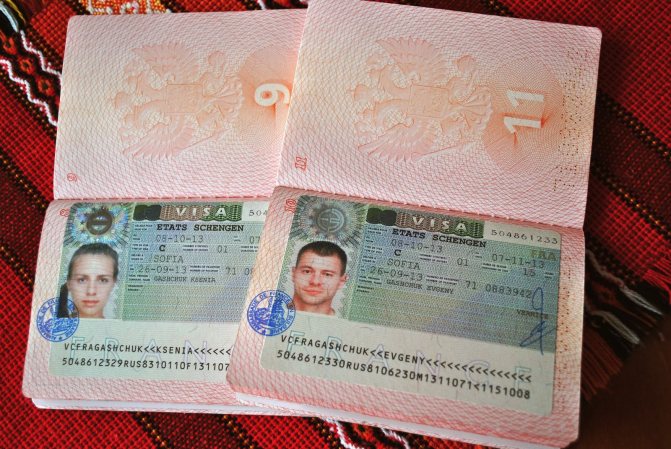
Also check that the visa is printed in good quality, without spaces or corrections. Handwritten corrections are not permitted! Such situations are extremely rare, but everything needs to be checked before you return home with a brand new visa in your pocket.
Visa deadlines
A mandatory attribute of any visa stamp that allows entry into the country is to indicate on it the so-called visa corridor (period for possible entry and exit). The word “From” and the numbers next to it indicate the date for permitted entry into the country. This does not mean that you need to cross the border on this particular day - the countdown of your stay period simply begins on it.
“Util” means the last day when you can still stay in the Schengen area. By adding up the number of days, it is easy to figure out how much the visa corridor is. If the tourist was heading to Germany and on the last day of his stay he left for Poland, then this will also be considered a violation.
The expiration date of the visa must coincide with the day on which you leave the Schengen zone. If the plane is delayed on the last day of travel, you will have to stay in a special area of the airport, since it is no longer possible to travel to the city.
Read also: Amount of fine for a passport Temporary passport
Basic provisions

Having a certificate of entry into the Schengen countries gives the holder the right to move freely within their territory. You can stay in these countries for no more than 3 months every six months. Resettlement rules should not be violated, as this may result in unpleasant issues for the tourist in the future or lead to a refusal to issue permission to enter a foreign country.
It must be remembered that a Schengen visa is requested in the country in which the traveler intends to spend more time. If the time is not specified or is divided into an equal period of time, then the application is made in the country whose border will be crossed first.
Read about how to get Schengen yourself by following the link.
Which country issued the permit?
The entry permit number (Schengen) is assigned at the consulate of the country that issued it. After reading it, the border guard will immediately understand where it was issued and has the right to ask why the traveler, for example, crosses the border in Finland if he issued a Schengen visa to Spain.
The inscription “Etados Schengen” indicates that the visa holder has the opportunity to travel throughout the Schengen area. But if a single-entry visa was issued at the consulate of a certain country, then there is an unspoken rule of first entry, when it is desirable to cross the border of the zone in this country.
If instead of the inscription “Shengen” there is a symbol of the country in which you can stay, then the rule of first entry cannot, in principle, be violated. For Germany it will be the letter “D”, and for Spain it will be “E”.
A complete list of all country encodings can be easily found on the Internet. If you don’t know, for example, “LTU” – visa of which country, then you can easily find out that we are talking about Lithuania. This designation should not be confused with “LTV”, which stands for short visa for humanitarian travel or “LVA” (code of Latvia). If there is space, then instead of the symbol “D” or “LTU” the full name of the country (“Germany”, etc.) can be entered.
Checking data when receiving a stamp
Although employees of the Schengen mission are attentive to checking data even during the reception of documents, no one is immune from errors. To avoid annoying discrepancies being discovered when going through passport control at the border, it is advisable to check the accuracy of the data immediately after receiving the visa.
What to pay attention to:
- Valid term of a visa.
- Length of stay (exact number of days).
- Correct spelling of last name, first name, and passport details.
- Availability of a consular service seal.
- Machine readable code.
If there is an unclear note (code or confusing wording), it is advisable to clarify its meaning with the consular service. Perhaps we are talking about some restrictions, which you should know about in advance.
In addition, holders of multiple visas need to carefully consider entering the Schengen territory. Since there is a lot of conflicting information published on the Internet, it is safer to seek clarification directly from the consulate of the destination country or from the official website of the Schengen State representative office.
Where is the visa type indicated?
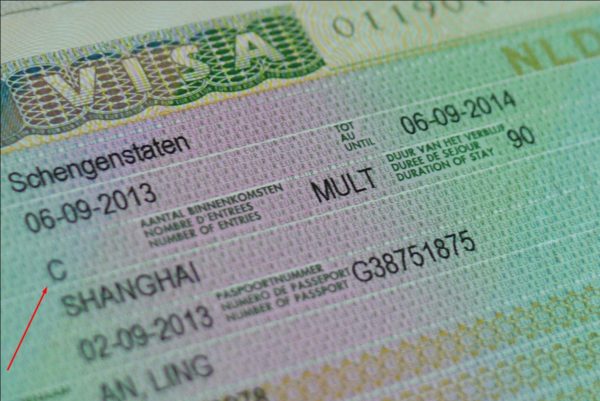
There are different types of Schengen visa depending on the duration of the trip and its purpose. The most popular type is “C”, and it is most often issued for tourism and trips to visit relatives or friends, and business trips. The visa type can be seen under the date at the very top of the sticker in the passport.
What is a multivisa
You can find out what a Schengen multiple entry visa looks like by comparing the stamp in your passport with the mark indicating the possibility of single entry. They differ little - for a multiple entry visa the number is 0, for a single entry visa the number is 1, and for a double entry visa it is 2.
The “Mult” permit indicates where the visa was issued, what type it is, the duration of the visa corridor, the number of days for possible stay (for example, 90 days). At the bottom of the multiple entry visa there is also an encoding for quick identification by the scanner. How to get a multiple visa? You should act accordingly:
● you need to have travel to Europe, or better yet an annual Schengen visa;
● collect the required package of documents and pay the visa fee;
- submit the package to the visa center or consulate and wait to receive a stamp in your passport.
Obtaining a multiple visa is not easy, since you need compelling reasons for multiple entries into the EU and stable high income if you plan to stay there for a long time. If a person has never been to Europe before and immediately applies for a multiple-entry visa, then most likely he will receive a single-entry visa. The first time a multiple visa will definitely not be given for a period of 5 years. First, for six months to a year, then you can apply for a permit with a longer period of stay.
Documents required to obtain a Schengen visa
To apply for a Schengen visa, the applicant must provide:
- a valid passport, the validity of which must exceed the expiration date of the visa you are requesting by 3 months;
- Questionnaire of the established form.
- Photocopy of all pages of the internal passport.
- Photos of the established standard (3.5 X 4.5).
- Documents that can confirm the purpose of the trip. This could be a business or private invitation, a tourist voucher, etc.
- Medical policy valid for the entire period of stay in the Schengen countries (Insured amount must be at least 30,000 euros)
- Certificate of employment on company letterhead indicating the position and salary.
- Documents confirming the availability of funds (certificate of purchase of currency for the required amount, current bank account statement).
To obtain a Schengen visa, children under the age of majority traveling with one of the parents or accompanied by a third party must provide the child’s birth certificate (original and copy certified with an Apostille stamp), a copy of the parents’ marriage certificate, copies of general Russian passports and foreign passports (if available) parents, a notarized power of attorney (original and copy) from the parents (in the event of the death of a parent, a death certificate certified with an Apostille stamp is provided. If the whereabouts of the parent is unknown, then a police certificate is provided).
Visa coding
When deciphering Schengen visas for ordinary tourists, not all information is important. Most of the information encrypted on the visa stamp is more important for border control. For tourists, the following are important: the area of validity of the visa (the entire territory of the Schengen area or just one country), length of stay, and whether the type of visa corresponds to the one requested when applying to the embassy. Naturally, you need to check whether the last name is entered correctly and whether there is an error. Visa symbols (letters and numbers):
- number with a letter designation (the country that issued the entry permit is encoded);
- type C, D or A;
- number of entries – 1, 2 or Mult;
- name of the country: CH (Switzerland), CZE (Czech Republic), D (Germany), PL (Poland) and so on, or the inscription “Shengen” in the language of the country that issued the permit;
- number of days of stay (for example, indicate the number 90);
- "Remarks" (notes);
- passport number (digital order) and number of registered children (for example, 1X).
For border guards, what matters is the number of the entry permit and the code of the country that issued it, and most importantly, the ability to determine the authenticity of the passport, the validity of the visa, and the presence of additional marks on it. The photograph that is on each permit stamp to visit the Schengen country must also be checked. Authenticity is determined by the number that enters the system.
Appearance of visa permit
To travel to European countries, in most cases a special permit is required. We will focus on the technical aspects of the visa stamp pasted into the international passport, which is popularly called simply “Schengen”.
What does a Schengen visa look like in a passport?
The main features of the color insert are the visa number, a photograph of the document holder, several laconic fields with filled-in data and an area with an alphanumeric code.
The purpose of the latter is to speed up the identification of the traveler’s identity as much as possible.
As a rule, the names of the fields to be filled in are presented in three languages:
- country that issued the visa;
- French;
- English.
For obvious reasons, the exception is the French visa stamp - its fields are presented in only two languages.
Like any important document, each visa stamp has a unique number, which is entered into a common database. Where is the Schengen visa number in the passport? This number is indicated in the upper right corner of the insert and consists of 9 digits.
How to read information in a visa decision
Many travelers have at least a basic level of knowledge of one of the languages used in field names. But even for them, reading a visa can be difficult. A short explanation of special terms will be helpful.
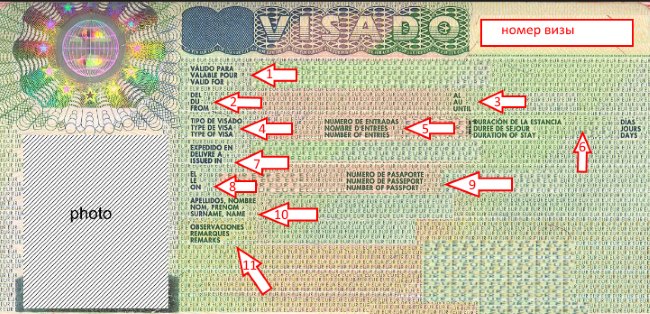
- VALID FOR - countries in which the visa is valid. Most often, this field contains wording that means that with this visa you can visit the entire territory of the Schengen zone. The phrase “Schengen countries” is indicated in the language of the state that issued the visa. In the upper right corner is the letter code of the country whose consulate issued the visa.
Another option is a list of countries to which entry is prohibited, as evidenced by the presence of a minus sign.
- FROM — visa start date. It is indicated as follows: DD-MM-YY.
- UNTIL - date of expiration of the visa permit.
- TYPE OF VISA - type of visa, indicated in Latin letters:
- A - transit
- C - short-term (tourist);
- D - long-term (work, study, etc.).
- NUMBER OF ENTRIES - possible number of entries (one, two or multiple).
- DURATION OF STAY - the maximum number of days that a visa holder can spend in the Schengen area.
- ISSUED IN - the authority that issued the permit (usually the city in which the representative office that reviewed the application is located is indicated).
- ON - date of issue of the permit.
- NUMBER OF PASSPORT - the number of the international passport in which the visa stamp is affixed.
- SURNAME, NAME - last name and first name of the document owner.
- REMARKS - notes. Most often this field is left blank. Sometimes the embassy of a country may put down a code for the purpose of the visit (for example, in a Polish visa 01 means tourism, 04 - business visit, 15 - treatment, and the Germans use the wording TOURISTISCHEN VISUM ERWERBSTATIGKEIT NICHT GESTATTET to emphasize that a tourist visa is issued without the right to work).
At the bottom of the visa stamp is a unique code that is read by the machine during passport verification.
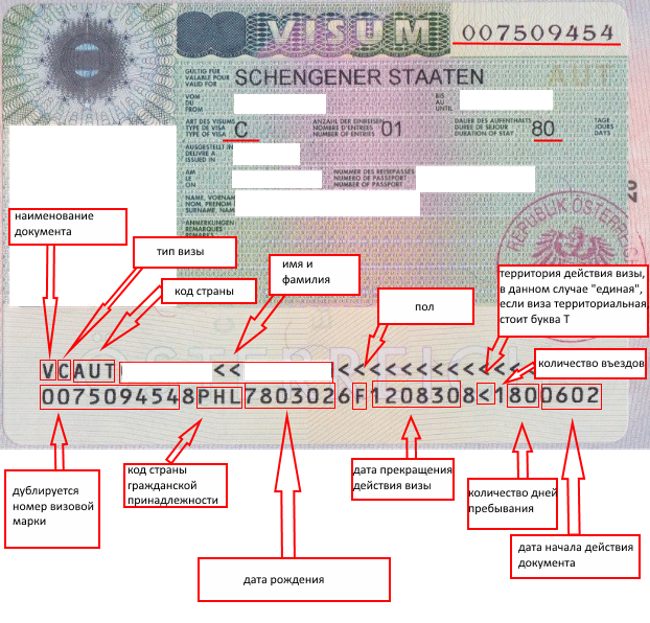
Those who are looking for information on how to read a Schengen multiple entry visa should know that this permit document is practically no different from a single or double entry visa. The only difference is the mark in the “Number of entries” field, which determines the number of possible entries: if the corresponding number is indicated in the permit for a single or double entry, then the holder of a multiple visa will find the designation MULT in this field.
How to read the bottom lines of a Schengen visa?
1st line by signs:
- 1st position – V sign;
- 2nd entry permit type code (A, B, C, D);
- from 3rd to 5th position - the state issuing the visa;
- From 6th to 36th the last name and first name are indicated.
2nd line by signs:
- from 1st to 9th position – permission number, as in the upper right corner;
- 10th – control sign;
- from 11 to 13, the citizenship (country code) of the traveler is indicated;
- from the 14th to the 19th position the date of birth in the sequence: year, month, day;
- 20th – control mark according to complex calculation according to the algorithm defined by ICAO;
- 21st gender is indicated: F – female, M – male, “<” – unknown;
- from the 22nd to the 27th – the end date of the entry stamp;
- 28th control character;
- 29th position – territorial validity: “T” – visa with limited validity, “<” – single visa;
- 30th – number of departures: 1, 2 or M;
- from 31st to 32nd – length of stay;
- from the 33rd to the 36th – the visa begins to be valid in the format: month and day.
After studying this information, answering the question of how to read a Schengen visa will not be difficult. This will allow you to become a professional in such matters, as well as help inexperienced travelers with such a problem. Remember, the more a person knows, the fewer questions he has.
passporta.org
Long-term visa is issued
The maximum validity period of a long-term visa is one year
If a foreigner needs to stay in the Republic of Latvia for more than 90 days within six months, counting from the first day of entry, if this:
- complies with international legal standards;
- corresponds to the interests of the Latvian state;
- due to unavoidable circumstances;
- connected with humanitarian considerations.
If the purpose of entry of a foreign citizen is to obtain a residence permit in the Republic of Latvia based on the decision of the Office to issue a residence permit. In this case, a single long-term visa is issued with a validity period of up to 30 days.
The maximum validity period for a long-term visa is one year.
A foreigner who has a valid long-term visa (visa category D) issued by any other country party to the Schengen Treaty may enter and stay for a short time (no more than three months within six months) in the territory of another country party to the Schengen Treaty, if it complies entry requirements specified in the Schengen Border Code and in the Schengen information system are not subject to an entry ban.
Reminder for travelers
A permit certificate is not considered a 100% guarantee of admission to European countries participating in the Schengen Agreement. Everything will depend on the authorized person in uniform at the border.
See also: An easy way to travel around Europe - applying for a Schengen visa
In addition to an identity card with a visa, the departing subject has the right to provide additional information to the migration officer. To confirm the purpose of the visit, they usually provide a hotel reservation and information from a travel agency, a letter from an employer or organization, and availability of valid health insurance.
To prove to the migration officer that the owner of the passport and exit permit is financially secure, as a rule, they provide a certificate of the employee’s salary, as well as proof of the person’s solvency (bank card statement or cash). The migration officer can be provided with round-trip air tickets, as this also influences the final verdict.
After receiving a permit from the Consulate or Embassy of a Schengen country, you need to visually examine the visa. It is necessary to make sure that all inscriptions are made automatically, without any entries, marks, or corrections. The visa sticker bears the stamp of the Consulate, certified by an employee of the Embassy.
How long does it take to process?
Taking into account that each consular office, when issuing travel documents, is guided by the working calendar that is in force in their country, the processing time for a Schengen visa may vary. Therefore, a citizen can sometimes receive a completed document 5 days after submitting documents, and sometimes after 14 days. If the application was submitted in July-August, the issuance period may be delayed even more. Accordingly, this also affects the ability to check the status of a Schengen visa.



